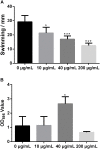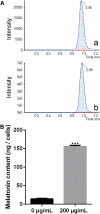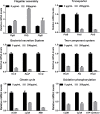Melatonin Treatment Inhibits the Growth of Xanthomonas oryzae pv. oryzae
- PMID: 30337911
- PMCID: PMC6180160
- DOI: 10.3389/fmicb.2018.02280
Melatonin Treatment Inhibits the Growth of Xanthomonas oryzae pv. oryzae
Abstract
Xanthomonas oryzae pv. oryzae (Xoo) causes rice bacterial blight (BB), one of the most widespread and destructive diseases in rice-growing regions worldwide. Melatonin enhances pathogen resistance by inducing plant innate immunity, but the direct effect of melatonin on plant pathogenic bacteria is poorly understood. In this study, we investigated the direct effects of melatonin on Xoo. Exogenous melatonin at 200 μg/mL significantly inhibited the proliferation of Xoo and reduced the mRNA expression of five genes involved in cell division. This concentration of melatonin also inhibited the motility and biofilm formation of Xoo. Notably, melatonin was observed to alter the length of Xoo cells. To provide deeper insights into the mechanisms underlying this antibacterial activity, we examined global gene expression changes in Xoo strain PXO99 in response to the application of 200 μg/mL melatonin using RNA sequencing (RNA-Seq). A wide range of differentially expressed genes (DEGs) related to catalytic activity and metal-binding activity were downregulated in Xoo cells in response to the melatonin treatment. In addition, DEGs responsible for carbohydrate and amino acid metabolism were also downregulated. These results suggest that the inhibitory mechanism of melatonin on Xoo proliferation may involve the regulation of cell division in combination with a reduction in the concentration or activity of enzymes involved in metabolism.
Keywords: Xanthomonas oryzae pv. oryzae; antibacterial action; growth; melatonin; transcriptome.
Figures








Similar articles
-
Time-resolved pathogenic gene expression analysis of the plant pathogen Xanthomonas oryzae pv. oryzae.BMC Genomics. 2016 May 10;17:345. doi: 10.1186/s12864-016-2657-7. BMC Genomics. 2016. PMID: 27165035 Free PMC article.
-
Proteomic and Transcriptomic Analyses Provide Novel Insights into the Crucial Roles of Host-Induced Carbohydrate Metabolism Enzymes in Xanthomonas oryzae pv. oryzae Virulence and Rice-Xoo Interaction.Rice (N Y). 2021 Jun 26;14(1):57. doi: 10.1186/s12284-021-00503-x. Rice (N Y). 2021. PMID: 34176023 Free PMC article.
-
OsNPR1 Enhances Rice Resistance to Xanthomonas oryzae pv. oryzae by Upregulating Rice Defense Genes and Repressing Bacteria Virulence Genes.Int J Mol Sci. 2023 May 12;24(10):8687. doi: 10.3390/ijms24108687. Int J Mol Sci. 2023. PMID: 37240026 Free PMC article.
-
Rice versus Xanthomonas oryzae pv. oryzae: a unique pathosystem.Curr Opin Plant Biol. 2013 May;16(2):188-95. doi: 10.1016/j.pbi.2013.02.008. Epub 2013 Mar 4. Curr Opin Plant Biol. 2013. PMID: 23466254 Review.
-
The Roles of MicroRNAs in the Regulation of Rice-Pathogen Interactions.Plants (Basel). 2025 Jan 6;14(1):136. doi: 10.3390/plants14010136. Plants (Basel). 2025. PMID: 39795396 Free PMC article. Review.
Cited by
-
Melatonin Analogues Potently Inhibit MAO-B and Protect PC12 Cells against Oxidative Stress.Antioxidants (Basel). 2021 Oct 12;10(10):1604. doi: 10.3390/antiox10101604. Antioxidants (Basel). 2021. PMID: 34679739 Free PMC article.
-
A Phytomelatonin-Rich Extract Obtained from Selected Herbs with Application as Plant Growth Regulator.Plants (Basel). 2021 Oct 9;10(10):2143. doi: 10.3390/plants10102143. Plants (Basel). 2021. PMID: 34685952 Free PMC article.
-
Phytomelatonin in stress management in agriculture.Heliyon. 2021 Mar 8;7(3):e06150. doi: 10.1016/j.heliyon.2021.e06150. eCollection 2021 Mar. Heliyon. 2021. PMID: 33748446 Free PMC article. Review.
-
Have All of the Phytohormonal Properties of Melatonin Been Verified?Int J Mol Sci. 2024 Mar 21;25(6):3550. doi: 10.3390/ijms25063550. Int J Mol Sci. 2024. PMID: 38542522 Free PMC article. Review.
-
GC-MS and Network Pharmacology Analysis of the Ayurvedic Fermented Medicine, Chandanasava, Against Chronic Kidney and Cardiovascular Diseases.Appl Biochem Biotechnol. 2023 May;195(5):2803-2828. doi: 10.1007/s12010-022-04242-7. Epub 2022 Nov 23. Appl Biochem Biotechnol. 2023. PMID: 36418713 Free PMC article.
References
-
- Arnao M. B., Hernández-Ruiz J. (2017). Growth activity, rooting capacity, and tropism: three auxinic precepts fulfilled by melatonin. Acta Physiol. Plant 39:127 10.1007/s11738-017-2428-3 - DOI
-
- Blask D. E., Sauer L. A., Dauchy R. T., Holowachuk E. W., Ruhoff M. S., Kopff H. S. (1999). Melatonin inhibition of cancer growth in vivo involves suppression of tumor fatty acid metabolism via melatonin receptor-mediated signal transduction events. Cancer Res. 59 4693–4701. - PubMed
-
- Byeon Y., Back K. (2016). Low melatonin production by suppression of either serotonin N-acetyltransferase or N-acetylserotonin methyltransferase in rice causes seedling growth retardation with yield penalty, abiotic stress susceptibility, and enhanced coleoptile growth under anoxic conditions. J. Pineal Res. 60 348–359. 10.1111/jpi.12317 - DOI - PubMed
LinkOut - more resources
Full Text Sources

